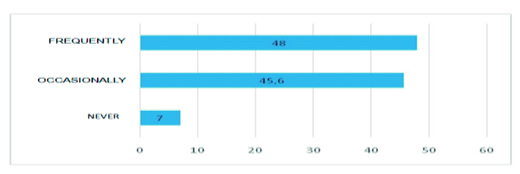
http://dx.doi.org/10.15198/seeci.2017.43.69-97
RESEARCH
MODEL OF PRODUCTION OF DIDACTIC VIDEOS FOR THE FACE-TO-FACE MODALITY OF UNIVERSITY EDUCATION
MODELO DE PRODUCCIÓN DE VIDEOS DIDÁCTICOS PARA LA MODALIDAD PRESENCIAL DE LA ENSEÑANZA UNIVERSITARIA
Ricardo Vélez Amador1
1Autonomous University of the Caribbean. Colombia
2Velez.amador@hotmail.com
1Ricardo Vélez Amador: Master of Science in Communication, Universidad del Zulia. Researcher Communication Group and Region. Professor Full Time Program Social Communication - Journalism. Autonomous University of the Caribbean
Correo: Velez.amador@hotmail.com
Accepted: 04/04/2017
Received: 15/06/2017
ABSTRACT
The present article describes a model that allows to produce didactic videos and it is deduced from the doctoral thesis "Design and validation of a model of production of didactic videos for the face to face modality of the university teaching". In addition, it is a contribution to the project "Design and implementation of an edu-communicative model to promote the culture of peace in the Caribbean region" (PRYINT-081-2017) developed at the Autonomous University of the Caribbean. A three-stage research was developed for its design. The first: It was diagnosed, under a quantitative approach, the didactic use that the university teachers of the city of Barranquilla give to the audiovisual. The second one was developed with a qualitative approach and aimed to consult a group of specialists in teaching and audiovisual production on the design of a model of production of didactic videos. The third: validated the model through the technique of 'expert judgment'. The nature of this study is framed within the complexity represented by the processing of audiovisual language and required a methodological treatment that would cover different dimensions of reality from a holistic perspective. Finally, an original model is presented that is applicable, since its viability was validated through expert judgment.
KEY WORDS: Model - Video - Audiovisual production - Didactic - University education.
RESUMEN
El presente artículo describe un modelo que permite producir videos didácticos y se desprende de la tesis doctoral “Diseño y validación de un modelo de producción de videos didácticos para la modalidad presencial de la enseñanza universitaria”. Además, constituye un aporte al proyecto “Diseño e implementación de un modelo edu-comunicativo para fomentar la cultura de la paz en la región Caribe” (PRYINT-081-2017) desarrollado en la Universidad Autónoma del Caribe. Para su diseño se desarrolló una investigación en tres fases. La primera: Se diagnosticó, bajo enfoque cuantitativo el uso didáctico que los docentes universitarios de la ciudad de Barranquilla dan al audiovisual. La segunda: se desarrolló con enfoque cualitativo y tuvo como objetivo consultar a un grupo de especialistas en docencia y producción audiovisual sobre el diseño de un modelo de producción de videos didácticos. La tercera: validó el modelo a través de la técnica de ‘juicio de expertos’. La naturaleza de este estudio está enmarcada dentro de la complejidad que representa el procesamiento del lenguaje audiovisual y requirió un tratamiento metodológico que abarcara distintas dimensiones de la realidad desde una perspectiva holística. Finalmente, se presenta un modelo original que resulta aplicable, puesto que su viabilidad quedó validada a través del juicio de expertos.
PALABRAS CLAVE: Modelo, Video, Producción audiovisual, Didáctico, Enseñanza universitaria.
How to cite this article
Velez Amador, R. Modelo de producción de videos didácticos para la modalidad presencial de la enseñanza universitaria [Model of production of didactic videos for the face-to-face modality of university education] Revista de Comunicación de la SEECI, 43, 69-97. Doi: http://dx.doi.org/10.15198/seeci.2017.43.69-97
Recuperado de http://www.seeci.net/revista/index.php/seeci/article/view/472
1. INTRODUCTION
One of the main concerns of current education systems around the world is the quest for quality. Increasingly, substantial financial resources are allocated every year for the education of the new generations. The concern for quality must therefore be conceived in this sense of the need to adapt to the new social challenges, to be able to put into practice new learning objectives, methods and procedures that prepare the new generations before this emerging society.
The production of didactic videos for university teaching in face-to-face modality is scarce, in contrast to distance learning where there are more experiences. Consequently, in the educational field there is a strong demand for experimentation for new forms of expression and didactic exploration for the complementarity of face-to-face education.
So far, audiovisual materials used by universities in their training process, according to (Salinas, 1995), are mostly cinematographic productions that are distributed in
video format, or documentaries and reports produced for television, and in general respond to programs of information or cultural nature intended for an average audience. This is due to the fact that the educational television productions are not many with respect to the commercial ones, in part, due to the fact that a more participative and dynamic didactic video production process has not been reached. Consequently, a frame of reference for the production of didactic videos is required.
The audiovisual media are, according to (Cabero, 1992) mainly curricular elements and as such they are incorporated in the educational context independently of that it facilitates an interaction “with”, “on” or “by” the media. Since we do not perceive them as mere transmitters of information, we recognize the possibilities they have as elements of expression. Therefore, a minimum technical, aesthetic and design training is required by the teacher and the student for their use. It is important not to forget that the pedagogical and educational value granted to them is not so much in the media product that they achieve, but in the process that must be followed that goes from the research work to the elaboration of a script and of the contents that are reflected in the same, to the instrumental learning required for the technical mastery of the equipment, not forgetting the necessary capacity in the locution, and the production and postproduction of the medium.
In this sense, one of the components to promote the appropriation and educational use of audiovisual media, is given on the production and management of digital educational contents, which is an aspect that, besides being considered of strategic order, has much relevance, since through this, it contributes to closing the access gap to information, promoting public access and open to knowledge; developing national capacities for production, strengthening collaboration and cooperation frameworks for production and management of educational content; consolidate the national offer of digital educational content and develop the capacity of access, use and reuse of content by educational communities.
These reasons suggest the need to strengthen the capacity of the educational use of audiovisual media and in particular of educational video to foster a culture of collaboration and cooperation to promote the exchange, reuse, adaptation, combination and redistribution of educational resources, and consolidate a wide national offer of public access resources that contribute to the improvement of quality in education.
2. SOME BASIC THEORETICAL CONSIDERATIONS
The following is a series of concepts that are considered necessary to understand the terminology used in the description of the proposed model for the production of didactic videos for face-to-face university teaching.
2.1. Model Concept
The model, according to (Aguilera, 2000, p.57), is a partial representation of reality; this refers to that it is not possible to explain a totality, nor to include all the variables that it may have, so far as it refers to the explanation of a specific phenomenon or process, always seen from the point of view of its author.
(Aguilera, 2000, p.57), defines the model as a pattern to be followed or shown to know something, there is also the idea that a model must be used to test a hypothesis or a theory, or only to be able to explain a process or an abstraction. Even if the explanation of a model is based on hypothetical assumptions or previous confirmed theories, it would be complete if it does not encompass subsequent observations and experiments that account for all those elements, mechanisms and processes included in it. The model explains the reality and the theoretical foundation explains the model.
2.2. Concept of Didactics
Around the concept of Didactics there exists a great wealth and plurality of definitions of several authors, which shows the evolution of the term itself from the evolution of knowledge.
Many are the definitions that are organized around the concept that we analyze. We highlight some of them:
• (Titone, 1974)
The teaching in its broadest sense, in that it tries to regulate the instructive process of intellectual formation, it is a methodology of instruction: but in its strictest sense it is also a teaching technology. It is a practical-normative science or theory of teaching praxis.
• (Fernández Pérez, 1977)
Didactics is the science that studies the teaching-learning processes in order to optimize the intellectual formation. Practical science that from a perspective of integrality, criticality and concreteness, studies the laws of formative instruction, without forgetting the problematic of its application, always having to the ends that education at all times proposes.
• (Escudero, 1978)
The Didactics is the science that aims at the orientation and organization of teaching-learning situations of an instructive nature, tending to the formation of the individual in close dependence on his integral education.
• (Pacios, 1980)
Science that studies the instructional process as it causes intellectual education.
• (Rodríguez Diéguez, 1980)
Didactics is the science and technique of educational instruction.
• (González Soto, 1989)
A scientific field of theoretical-practical and technological knowledge, whose central axis is the description -interpretation and projective practice of the intentional teaching-learning processes that are developed in contexts of relation and communication for the integration of culture in order to transform it.
Most of the current authors conclude that the material object of Didactics is the study of the teaching-learning process. This object is worked from the prism or perspective (called formal object), which consists in the prescription of effective methods and strategies to develop the mentioned process. (Ferrández, 1995, p.57), on the one hand, it affirms that the formal object of Didactics is the communicative, bidirectional process, between the teacher and the student that takes place in each didactic act. It is a question of analyzing the relationship between the two, and the methods and procedures used to achieve student learning, where elements such as the teacher-student relationship, the method, the subject or the content of learning, the cultural environment, etc. (Zabalza, 1990, p. 73), in a greater degree of concreteness, adds that the problems of study of this science are: teaching, curriculum planning and development, deep analysis of learning processes, innovations, Educational means, the process of teacher training and development, and special instructional programs.
2.3. Video as an educational tool
From its most original origins the video has been recognized as a possible pedagogical instrument of the first magnitude in the technical teachings. According to (Gruber, 2011), the use of video in class facilitates the construction of a meaningful knowledge since it takes advantage of the communicative potential of the images, the sounds and the words to transmit a series of experiences that stimulate the senses and the different learning styles in students. This allows to conceive a more real image of a concept.
In the current context we understand video on digital support, whether native or digitizing an analog video material, and by its very nature additionally allows the advantages of: Easy access and distribution. Whether on physical support (CD, DVD, flash-drive ...) or through the Internet (YouTube platform, repositories and others).
• Multiplicity of playback platforms both in fixed terminals (TV, personal computer desktop) and portable (laptop, notebook, smartphone, multimedia hard disk, tablet PC, video console, MP4 player, etc.).
• Ease of generation and editing. Starting from different source materials (photographs, texts, films, animations, music, voice, etc.) and without having to use very expensive resources (simply a personal computer and the appropriate non-linear video editing software), a pedagogical material of excellent quality that can be re-edited later to accommodate different scenarios of use can be generated.
The video, according to Bravo, (2000, p. 3) is a system of instantaneous capture and reproduction of the moving image and the sound by electronic procedures that as an audiovisual medium has a series of characteristics that distinguish it from the rest of the media that make up the audiovisual ecosystem. Among these features the following are included:
– It gives permanence to the messages and allows their exchange and conservation.
– Allows instant playback of recorded footage.
– Has a reusable medium a certain number of times.
– Allows the ordering of the different planes and sequences in an editing process.
– It is a support of supports, since it admits the transfer of productions realized by other procedures.
– Low image definition.
– Generates original microcommunication processes. The introduction of video in the classroom can produce substantial changes in the scenario where teaching takes place. If this introduction is occasional, the video, can become an element of distraction or simple lightening of the task in the classroom. If its use is widespread and continuous, it becomes one more element of those involved in the educational process.
The video as a didactic resource presents a series of characteristics, such as its low cost or its ease of handling, that allow it to be present in different moments of the educational process: as means of observation, as means of expression, as means of self-learning and as means of assistance to teaching.
2.4. The didactic video
According to (García, 2014), during the last decades the video “is the audiovisual technique of greatest projection” (this trend continues to rise) and this is perhaps due to “the social interest that this medium has awakened.” According to Cabero (2002), this tendency is largely due to the decrease in the cost of equipment and materials for its use, the ease of the progressive use of the video recorder, the interest expressed by the managers of the different educational levels to equip their centers with such equipment and their introduction in a massive manner.
Similarly, according to García (2014), the use of video for didactic purposes responds to the favorable perceptions that students and teachers show towards the use of said medium, to a greater number of educational institutions where materials and equipment of video can be located to be used in the development of teaching, the increase of material produced commercially with didactic and / or educational content, and it is possible to add the growing number of television productions for didactic and educational purposes, which can be accessed through the Cable TV channels or thanks to the different social networks on the Internet.
Considering the above, it is possible to point out that video for teaching purposes has great potential and that its use in classrooms is an excellent way to achieve meaningful learning. However, it is necessary to specify that the video lacks educational advantages if it is not accompanied by a guide that guides the learner and the teacher in the different phases of the teaching and learning processes.
3. OBJECTIVES
3.1. General objective
Design a model that allows the production of didactic videos for the face-to-face modality of university education in Barranquilla-Colombia.
3.2. Specific objectives
In order to achieve this general objective, it was necessary to specify actions that allowed to obtain key information for the design of the model and that are specified in the following specific objectives:
1. Diagnose the didactic use that, within the teaching-learning process, teachers of the universities of the city of Barranquilla - Colombia give to the audio-visual.
2. Design a model proposal for the production of didactic videos that contributes to the development of the teaching-learning process in the face-to-face modality of the universities of the city of Barranquilla -Colombia.
3. Validate the Model for the production of didactic videos for university teaching in its face-to-face modality based on expert judgment.
4. METHODOLOGY
The developed methodology that resulted in the elaboration of a model for the production of didactic videos for university face-to-face teaching is framed within the complexity represented by the processing of language and audiovisual communication with its basic components of pre-production, production and post-production, therefore requires a methodological treatment that encompasses different dimensions of reality from a holistic perspective.
Three phases were defined in the research in accordance with the research method.
The first phase, with a diagnostic character, was intended to diagnose, under a quantitative approach and with the application of the survey technique, a representative sample of 349 teachers, the didactic use that within the teaching learning process they give to the audiovisual the teachers at the universities of the city of Barranquilla.
The second phase was developed with a qualitative approach, with the application of the semi-structured interview technique; And aimed to consult a group of specialists in teaching and audiovisual production to design a proposal for a model for the production of didactic videos that contributes to the development of the teaching-learning process in the face-to-face modality of the universities of the city of Barranquilla
The third phase consisted in the validation of the proposed model through the expert judgment technique. To this end, six (6) judges / experts were selected and an instrument designed for validation was applied.
Finally, the validated model was implemented in the production of a didactic video for university face-to-face teaching in the course of Audiovisual Narratives of the Autonomous University of the Caribbean.
In the present investigation there were two populations: the first one consisted of the 3,821 active classroom teachers of the six universities that have their main headquarters in the city of Barranquilla. These universities are: Autonomous University of the Caribbean, Universidad del Atlántico, Universidad del Norte, Universidad de la Costa (CUC), Universidad Metropolitana and Universidad Simón Bolívar. This population was studied in the first phase of the research to obtain the diagnosis of the use of the audiovisual in the classroom by the faculty of university teaching in Barranquilla. From this population a sample of 349 teachers was extracted and a survey was carried out.
For the study of the first population, integrated by classroom teachers from the universities of Barranquilla, we used the survey technique, under the form of a questionnaire with 29 items, as a recording instrument drawn from the ones made by Hernández (2006) where the survey is a technique that includes a set of resources intended to collect, propose and analyze information that are given in units and in people of a particular group, using a questionnaire or other type of instrument.
Sampling for the first population of this research was of stratified probabilistic type, since the questionnaire was applied to representative groups of classroom teachers from each of the six universities of Barranquilla within a lapse of two weeks. Chavez (2001) points out that stratified probabilistic sampling is the one that is carried out on the basis of population strata.
The second population was made up of six faculty experts in teaching and in the audiovisual area of the universities of Barranquilla that have academic programs related to audiovisual production and production. For this second phase of the research, corresponding to the design of a model proposal for the production of didactic videos that contributes to the development of the teaching-learning process in the face-to-face modality of the universities of the city of Barranquilla, this sample was chosen for convenience according to the criterion of the researcher and was integrated by the specialists in the area of university teaching and audiovisual by each one of the four universities that have academic programs related to audiovisual production and that contributed to the design of the proposed model.
DISCUSSION
5.1 Analysis of quantitative data
To characterize and evaluate the use of audiovisual in the classroom of the university teachers of the city of Barranquilla we use the results of the survey whose questionnaire of 29 questions was applied to the 349 teachers who constituted the sample of our first study population.
In synthesis in the universities of Barranquilla audiovisual contents are used infrequently by the classroom teachers, less than 50% use it. The use of audiovisual content, for the most part, is related to the complementation of classes and, therefore, to the enrichment of the teacher’s expository function. The insertion of audiovisual production exercises in educational practices is also not widespread: 75% of the classroom teachers in the city of Barranquilla use the audiovisual in their classes in order to complement the learning of their subject. Another 15% use it to promote students’ personal skills and competences, only 6% to learn techniques and audiovisual language.
Graph 1: Frequency with which the audiovisual use as a didactic resource is used by university teachers of the universities of Barranquilla

Source: own elaboration (2017)
Continuing with this diagnostic synthesis, we must point out that the audiovisual format most used by the face-to-face university teachers of the city of Barranquilla in their classes is the specifically educational format with 75%, which shows that the didactic video is the most demanded by of university teachers in Barranquilla as a resource of support in the teaching-learning process.
Next, the most used audiovisual format is the documentary: about 70% of the face-to-face university teachers of the city of Barranquilla says they use them. Fairly distant are the reportage formats with 43%, the movie format with 37%, the animation format with 34% and finally the interview format with 20%.
Graph 2: Most used audiovisual format in classes.
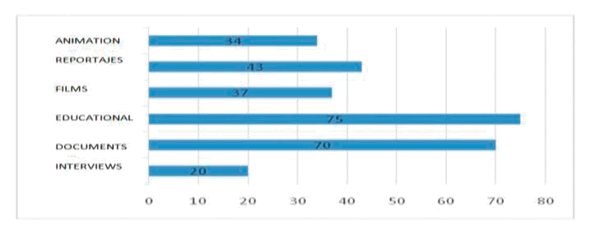
Source: own elaboration (2017)
Only 0.3% of the videos used as didactic resources by university teachers in the city of Barranquilla are self-produced, despite a significant 31.6% claim to have the production tools for the realization of their Educational videos
Graph 3: Source of the video used in classes.
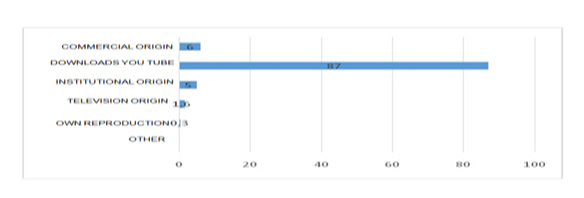
Source: own elaboration (2017)
To conclude, it is important to note that for all respondents - 349 university lecturers - to have production models for the production of didactic videos for university education is highly necessary to boost the production of audiovisual content of a didactic nature.
5.2 Analysis of qualitative data
The following is a summary of the results obtained from the interviews with the six selected teachers, where they sought to know their opinions, appreciations and considerations regarding the design of a model for the production of didactic videos for face-to-face university teaching. The semi-structured interview guide consisted of 12 questions. The interviews were recorded using recordings with the consent of the interviewees. Then they were transcribed in a perfectly readable format.
Table 1: Categories of analysis considered in the interviews with the 6 teachers who are experts in audiovisual production.
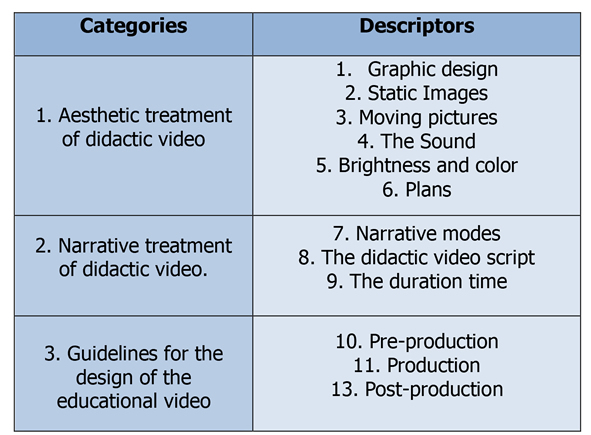
Source: own elaboration (2017)
5.2.1. Aesthetic treatment of didactic video
In this category of aesthetic treatment of didactic video: sound, color, texts, plane size, rhythm of images and sounds, etc., are the different elements in which we have to think, both individually and in their overall functioning, when designing the model proposal for the production of didactic videos for face-to-face university education.
As for the management of the planes in a didactic video for university teaching face-to-face the experts considered that the plane is the nerve center of the construction of the image. It is the intersection between times, sizes and angles of the image managed through composition, framing, movement and field.
5.2.2 Narrative treatment of didactic video
In this section, the experts emphasized the existence of several narrative modes for the didactic video: the observational mode as an attempt by the producer of the video to present the content with very little writing allowing the images to speak, that is to say, through minimal aesthetic decisions and never betraying the reality that is captured. The interactive or participatory mode when the teaching videos are structured with interviews, therefore, the word and the close-ups of the people who comment on the information usually get high.
Finally, experts mention the expository mode evidenced in a very structured video, with maps, diagrams, drawings, infographics, examples and almost always driven by a descriptive “voiceover”. The reflective mode is based on the effect of estrangement, since the filmmaker intends that the student not only reflect on the content of the video but also on the process of enunciation of the content.
5.2.3 Guidelines for the design of the production of an educational video
In this section, the experts gave us their point of view about what should be the design of the production of a didactic video: the first thing to do is to define the didactic intention of that video that is desired. Then, identify what function you want to give it, that is, to arouse interest in a topic, introduce a theme, support the development of the theme, clarify a concept, conclude or reinforce a theme.
The experts agreed on the convenience of planning the three stages of audiovisual production: Pre-production, production and post-production. In pre-production two important aspects are combined, the first is artistic creation and corresponds to the typical work of pre-production of audiovisual materials. Here the idea is defined, the necessary synopsis and scripts are elaborated (technical, literary and storyboard).
DESCRIPTION OF THE MODEL
This model seeks to contribute to the effectiveness of the didactic video as an instructive resource in the face-to-face university teaching and is composed of three phases described below:
Figure 1: Phases of the production model of didactic videos for university teaching face-to face

Source: own elaboration (2017)
Pre-production phase
The pre-production comprises from the conception of the idea to the first day of production. Its purpose is to facilitate production and postproduction, in addition to achieving the foreseen objectives. It is the most complex and time-consuming phase of the entire project, due to the decisions made during its execution. Here is a brief guide on the process to be developed in this first phase of the model.
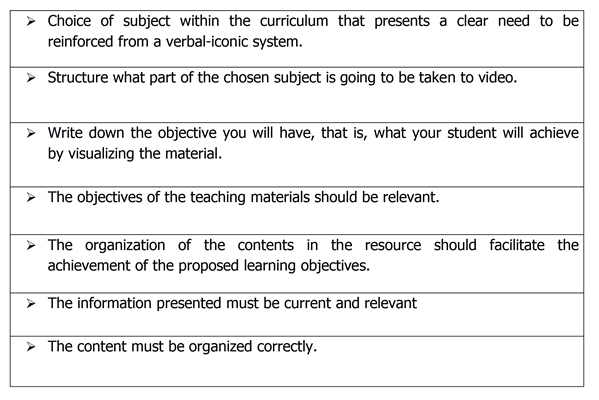
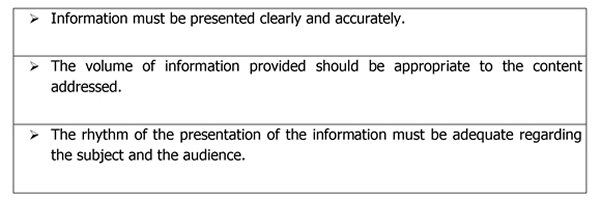
The selection of contents in the pre-production phase is a process of documentation and compilation of material such as texts and images that is or can be used later in the production of the didactic video. It is important to mention that this review should not focus exclusively on the conceptual terrain of the contents that will be presented in the medium, but must reach other components, which do not intervene directly on the content but they do give a dynamic and attractive touch, as can be color, sound effects, images, transitivity, music, posters, etc. It is necessary to look for existing materials that can support the development of the video, such as photographs, graphics, archival images, in which case it is necessary to request the necessary permissions to avoid incurring in copyright infringements.
For the organization of the content it is good to segment the content in historical milestones or more relevant aspects and to make a previous draft before beginning the process of elaboration of scripts. The incorporation of learning facilitators, such as schemas, concept maps, reiteration of concepts, incorporation of graphs and titles, search for examples and simulations, questioning, summaries, etc.
For the development of the thematic or content guide, the concepts, information and cognitive processes that will be the basis of the academic process developed through the video must be defined. The activities that are intended that the users-students develop with what is learned in the product should be indicated here. Finally, the production plan, that is a record of expiration in which each of the tasks to be performed are recorded and above all it is a record in which the members of the team appear and their main role in the development of the didactic video. It also records the duration and dates of each of the stages of the Budget that is another aspect that is defined in this phase, although in the recording of these didactic videos it is not necessary to hire actors, costumes and expensive special effects, instead it implies important expenses in recording materials, in displacements, permissions, authorizations and post-production expenses. These are the basic elements that should be considered in the budget of a didactic video: technical team (filmmaker, cameraman, editor, graphic designer), production team, transport, food, batteries, locations, stationery, general expenses and unforeseen expenses.
Table 2: Example of Production Plan
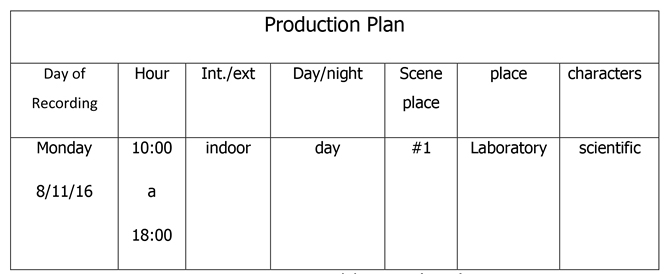
Source: own elaboration (2017)
The script of the didactic video is the written part of what you want to produce. The script is the core of the video, and in turn the most difficult to structure because different factors intervene, these factors may vary depending on the needs of the content, they may include the time that will be taken to develop a certain function, the time for music, the time for a certain sound, the time of presentation of an image, if there are dialogues, etc. For the elaboration of the didactic script it is recommended to define a title, a brief description of the subject to be addressed, the learning objective to be achieved, the target audience, a creative proposal or metaphor relating the subject to a situation of real life and a thematic structure attainable in a short video.
The first step in developing a didactic video will be to organize all the material that we have, structuring it according to a theme and objectives and establishing the tools and resources that will be used for this purpose. Previously, it will be necessary to take into account a series of factors, which are indicated below, according to (Dorrego, 2006):
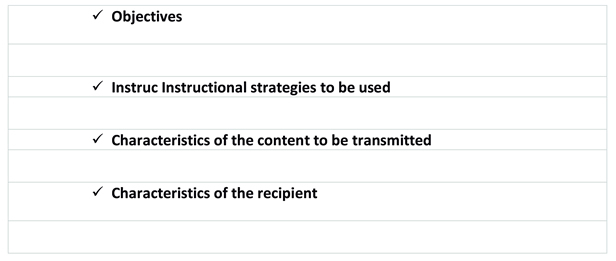

For the elaboration of a definitive script it is necessary to prepare a didactic plan for which it is necessary to prepare three types of different scripts:
The content script or basic outline, that presents in the most schematic way what we want to communicate.
The didactic or literary script, that shows the completely developed content.
Table 3: Example of literary script
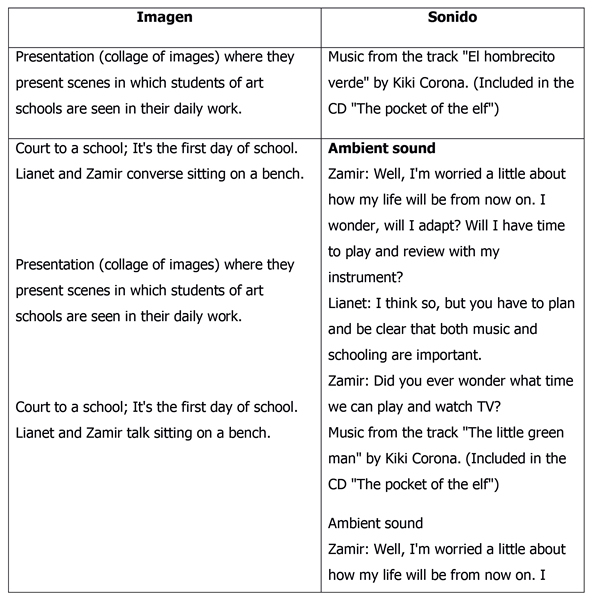
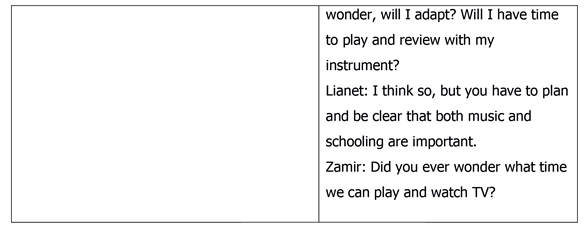
Fuente: (Hernández, 2008)
– The technical script that, in addition to the previous phases, includes those considerations relating to the realization of audiovisual material and will not be a teacher-producer competition but of the video-maker.
Table 4: Example of technical script
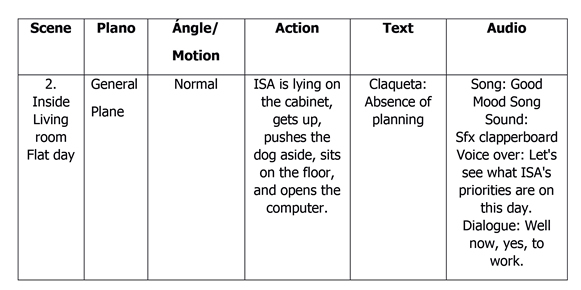
Required technical equipment:


• software that allows recording the screen of a computer, the recommended software is CamStudio which is free. CamStudio is a Windows application that allows you to record everything that happens on the computer desktop, recording both the full screen and defined zones, at the same time it makes the recording of the audio that is activated at that moment, and also You can make the recording from the microphone. A second option in Software is a program called Camtasia Studio, which has more video editing tools, compared to CamStudio, the disadvantage of Camtasia Studio is that it is not free software, you must buy the license.
• As far as audio production is concerned, teachers can create their own voice-over with Audacity (free distribution software available on the network), with which they can record their voice-over or voice-over by means of a desktop microphone or diadem In good quality and use it as a base for your video. Likewise, you could download free music from repositories covered by Creative Commons and that only require a credit of authorship in the material.
• You can also use images from television programs or videos available on the network. With this resource, special care must be taken, as some are protected by copyright. However, focusing on the educational purpose of these materials, and the openness provided by social networks, teachers could contact the original authors of such material and request a use authorization, obviously with the respective credit and include videos or testimonies Recorded by third parties in their didactic videos.
The production
While the pre-production phase is a decision-making that determines the content, appearance and methodology of the material, the development phase is the phase in which these decisions are put into practice and whose result is already a product. The production phase consists of carrying out the execution of the decisions taken in the previous phases, for this it starts from the scripts elaborated previously and is carried out with the technical elements that are available. This phase, which is part of the completion of the material, is based on its production.
Recommendations for recording:
It is important to point out that although the didactic production makes the aesthetic treatment subject to the achievement of some instructive objectives, we should not renounce to an artistic treatment of theme, which will undoubtedly make it more attractive in the eyes of students. In this sense, we must try to capture evocative images that adequately musicalized capture the attention of the viewer-student.
It is important to look for a suitable space to record and thus avoid errors that are then very difficult to correct in post-production. For this reason, it should be considered:
The light. Find a place with the best lighting possible, as this will determine the image quality in the video. The light should be directed towards the person and not be behind it. You could record without any additional light if you have adequate lighting, but if you have the possibility of placing more lights that improve lighting, they should try to be oriented in the following way:

Imagen 1: triángulo básico de iluminación
The main idea to consider is that the background and the person in front of the camera do not have shadows. Also, it is preferably that the light is neither very yellow nor white, but warm. Also if lamps are used, see that they do not overheat or disturb anyone in front of the camera.
Location. A place that allows comfort and privacy. It is very important to consider where will the camera go and therefore the background that will appear in the video. As much as possible make it in a cool place that allows the heat from the lights not to raise the temperature too much inside the room. In this way the teacher and the technical staff that is recording will feel more comfortable.
Background. It should not have anything that distracts the student’s attention or looks bad in the final product. A white wall without imperfections is correct, it could also be a bookcase, a picture, or something you would like your pupils to appreciate without distracting their attention. Another alternative that works very well is to place a photographic cloth on the wall, in such a way that it generates an even background, and an important property of this type of fabric is that no wrinkles are seen. There are many types of fabrics, the most important is to find one that is matte, which prevents the bounce of light in it, as this generates a point of brightness that looks bad in the recording.
Audio. You need as much silence as possible, so it must be in a closed space. That you can record without noise will also depend on the possibility of recording with a microphone. The possibilities you have for recording are: environmental microphone (it comes built into the laptop and in some cases in the webcam), or external microphone (which can be wired or wireless). The recommendation is an external microphone, there are many models and the choice will depend on the type of recording that is required.
Remember that it is very important that for a classroom class a video that is dynamic and well explained must be produced, but not do exactly the same class. You are free to use your imagination to craft the videos as best you can.
Video recording. We mainly have 2 methods to record a video:
1. Computerless Recording: This can be done using a camera that has the option of recording video, or using a Smartphone with video option. In both cases it is important to follow the recommendations indicated above.
2. Recording using a PC: you will need a computer, a webcam, a microphone (external or built-in) and a software suitable for capturing what we are doing on the computer.
PC Video Recording Software
The software we are recommending is called Screencast-O-Matic, which is free and can be downloaded from this web address:
http://screencast-o-matic.com/download
Direct link:
http://download.cnet.com/Screencast-O-Matic/3001-13633_475734109.html?hlndr=1 &part=dl
The software allows us to capture in video everything that we do in the PC and at the same time perform the capture of the Webcam (audio + video). It is important to have minimum recording requirements such as: a PC or laptop, a microphone and a webcam.
The Post-production
Once the material is achieved or recorded according to the needs of the specific script the third and final phase of this model is entered, the Postproduction. Like the two previous phases, pre-production when you plan what will be done and the production in which the plan is executed and takes advantage of last-minute circumstances that were impossible to predict or plan. In the postproduction the audiovisual assembly is concretized, it is in this phase that the recorded begins to take shape.
The postproduction is recognized by the most important function, the edition of the images and of the audios or sounds. Editing is the technical-conceptual process of expressing a message from strategically sequenced images and sounds. Postproduction becomes a great support point, because with specialized software for video editing like Avid Studio, Premiere or AfterEffects for the insertion of graphics, animations and graphic support, the recorded material can be reinforced and enriched, taking out the greatest benefit of visual communication of the educational messages to be shared. Once again the operating systems offer free and user-friendly options that serve this purpose, such as Windows MovieMaker for Windows or iMovie for Mac. In both cases you will get a basic video in WMV, AVI, MGP or MP4 format.
In order to share the audiovisual resources in the network, the teacher can optimize them and convert them to the required format using other free software called Any Video Converter, according to the technical dispositions proposed by each institutional repository (Codec, size - weight - and format).
Stages of Post-production
It is necessary and very important to make an inventory of all the recorded images for the didactic video, to then make a selection, organization and assembly of all the elements, with this classification starts the final edition.
• Preview
Before editing it is important to use the material that was recorded in order to select the images that will definitely be in the video. In this work it is recommended to make a complete and systematic inventory of everything that has been recorded.
To organize the different parts of the video, regrouping the plans that relate to the topics developed. This organization must have a beginning, a development and an end, besides a determined duration.
The last part of the post-production consists of physically assembling all the sound and visual elements that make up the video. An operation that can be definitive, if it is a final edition of the didactic video or preliminary if it is a pre-edition subject to conceptual or rhythmic changes.
• Editing or montage
In the modern digital edition, we work with digital signals that do not depend on a linear and sequential support as on the magnetic tape. The montage can be done in any order and place of space and time of the support, denominated in this sense as non-linear editing.
The montage is the narrative and rhythmic ordering of the elements of the story. It is the process of choosing, ordering and joining all the planes shot according to the previous idea and a rhythm appropriate to that idea. To set up the didactic video we recommend a pedagogical sequence that explains the different moments that will be in the video, it is suggested that it has three parts: Start (motivation and clarification of objectives), the development of the theme to be treated and a closing, in which you can mention the most important point to remember and conclude with an open question to invite them to action.
Here are some video editing tools that offer you various options according to your needs.
1. Windows Movie Maker for Windows, iMovie for iOS. Good options for simple video editors to manipulate your recordings, cuts, paste and delete parts, add audio, create transitions, overlays titles and text ... You can use videos recorded with a camera or created with other tools.
2. WeVideo. A very interesting tool to edit video in the cloud and online through the browser itself and in any media: computer, tablet or mobile. The free version has some limitations but is perfectly operative, the Premium also allows the collaborative work of several people invited to the same project.
3. PowToon. A more creative and fun option, if you want to give a dynamic and animated component to your video, through little toys, sandwiches or drawings, texts in movement, etc.
4. CamStudio, BB FlashBack Express or HyperCam. Programs to capture the computer screen. They are very useful, for example, to make videotutorials, record instructions for using applications and programs or display recommended web pages on a topic.
5. Flixtime, Animoto or PopcornMaker. Perfect for you to create simple presentations or for your students to start creating videos. They allow to include images, short videos, audios and texts. Popcorn is free, while Flixtime and Animoto have free versions with some limitations and full payment versions.
• Narrative Texts
The narrative text is a monologue, even if it is read by two people (male and female voices of preference). Narrative content should always enrich images so that the student can extract the information necessary to understand, decode or interpret a meaning that is not evident in the images. A true text can be a comment, a generalization, a synthesis or also an analogy from the images presented, but never describe textually what you see on the screen. This can cause a split in the attention of the student, who would not know that he would benefit more from, to look or to listen. It is necessary to leave pauses between the texts, because it risks to annoy the student and therefore to lose the interest.
• Music and sound effects
Music is an essential element in any audiovisual production. Narrative threads that keep the student’s attention to the video content can find their equivalent in sound reproduction. Key information from the instructional video can be highlighted with appropriate sound effects.
The music helps to immerse the student in a particular environment, and to create in him expectations linked to his way of associating ideas and feelings, hence the need to select the music correctly. This can contribute to relate some planes with others and give the impression of continuity of the images.
VALIDATION OF THE MODEL
For the validation of the model, a validation instrument was designed whose construction was derived from the following process:
1. Determination of validation criteria.
2. Construction of the validation instrument.
3. Preparation of explanatory documentation for judges
4. Analysis and integration of the results of the obtained answers.
After selecting the professionals who formed the group of experts for the validation of the Model of production of didactic videos for university teaching face-to-face, we proceeded to define and conceptualize the criteria that serve as parameters of assessment for the experts responsible for this task. In the following table, these evaluation criteria are specified:
Table 5: criteria for validation

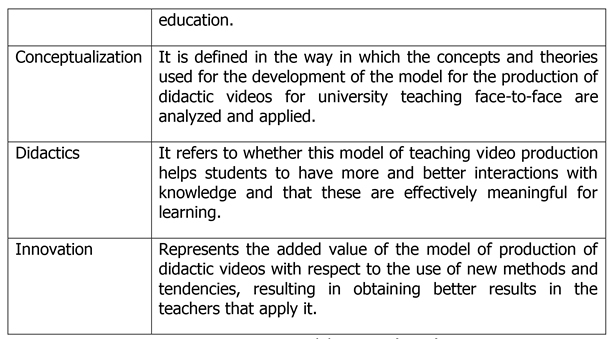
After applying these evaluation criteria, the experts considered that the implementation of the model for the production of didactic videos for face-to-face higher education, as a proposal to improve and update the resources, has a great impact both for the education sector and for the. University education face-to-face; backing this statement with the values presented, where 67 percent of the experts consider it to be of very high impact, while for another 33 percent of experts this new proposal represents a high impact.
Most of the experts who carried out the validation described agree that the proposed model can be effectively used as a mechanism to aid in the improvement of face-to-face university education where it is applied, demonstrating this fact by 34% of very high impact, another 33 percent of high impact and lastly a moderate impact that garnered the attention of a remaining 33 percent. All of the validating experts agreed to confirm that the sequence of steps followed within the methodology used in the model for the production of Educational videos proposed is completely consistent and suitable for the purpose that is wanted to achieve in the practice of university education.
The experts considered the proposed model for the production of didactic videos for the high education face-to-face teaching of high didactic aid so that the best interactions with knowledge are effectively meaningful for learning in 67% and 33% considered that the model would be of moderate help for significant results in learning. The innovative effect of the methodology applied to the proposed model based on the production of didactic videos for the face-to-face university teaching of the universities of Barranquilla is kept in mind by all the group of experts that carried out the validation, as all agreed with that response, although one group was biased because the methodology was considered of a high level with 33 percent, the rest of the group considered it to be of very high innovative level with 67 percent.
The results, in addition, reflected that all the experts considered that the model of production of didactic videos for the university face-to-face teaching of the universities of Barranquilla, is a new tool; Which also offers the improvement in higher education.
6. APPLICATIONS AND LINES OF RESEARCH
One of the most important achievements of this research lies in the terminological compendium. The knowledge of all those concepts that surround the new production of didactic videos. Aspects that help to understand the now and that can be extrapolated to new diversifications of audiovisual formats. It was possible to agglutinate concepts and refresh theories so that future audiovisual researchers can take as reference in their works about the audiovisual use of education, of the visual culture that surrounds us and of the didactic video itself. A model to produce didactic videos that must be treated in all its variants and that should serve as a basis for future research.
On the other hand, the production model for didactic videos is a field that has never closes. This thesis has tried to propose some guidelines for its production, however the most interesting work is in progressing on the new steps of didactic video in the hands of the Internet and as an audiovisual form of changing objectives, as we said. We are in the era in which the smartphone dominates the consumption of contents in Internet, being the predominant support in the new hypermodern society. The didactic video must continue to be transformed into an ideal resource for mobile audiovisual education with a clear tendency towards interactivity.
Currently, there is an obvious trend towards visualization that fits with the particularities of viewing in small devices. The study of the aesthetic and narrative peculiarities of this new didactic video has begun to be glimpsed in this investigation, but undoubtedly an in depth analysis of the new situation demands continuous contributions in the next years.
Finally, I hope that this research that starts here may serve as a theoretical step for new researchers in the use of audiovisual in education, in any of its branches: narrative, aesthetic, semiotic, sociological or technological.
7. REFERENCES
1. Aguilera J (2000).Modelo Querétaro: CIIDET, Maestría en Ciencias en Enseñanza de las Ciencias.
2. Borrás J, Colomer A (1987). Guion del vídeo didáctico. Fundación Serveis de Cultura Popular. Barcelona: Editorial Alta Fulla.
3. Cabrero J (1992). Dimensiones generales para la evaluación de los medios de enseñanza. En Sancho J (coord.). Para una tecnología educativa. Barcelona: Horsori. 247-249.
4. Cabrero J (2002). Propuestas para la utilización del vídeo en los centros educativos. http://tecnologiaedu.us.es/Revistaslibros/Ballesta.html.
5. Carmona R (1996). Cómo se comenta un texto fílmico. Madrid: Ed. Cátedra.
6. Cebrián M (1987) El vídeo educativo. Actas del II Congreso de Tecnología Educativa. Sociedad Española de Pedagogía. 55-74.
7. Dorrego E (1991). Modelos para la producción y evaluación formativa de medios instruccionales aplicados al vídeo y al software. Revista de Tecnología, 12(3).
8. Escudero JM (1978). Modelos didácticos. Planificación sistemática y autogestión educativa. Barcelona: Oikos-tau.
9. Espinosa S, Abbate E (2005). La producción de vídeo en el aula [Video production inside the classroom]. Buenos Aires, Argentina: Colihue.
10. Fernández M (1977). Programación. En Fernández Pérez M, Gimeno Sacristán J, Zabalza Beraz M. Didáctica II: Programación, Métodos y Evaluación. Madrid: UNED.
11. Ferrández A (1995). Didáctica General. Barcelona: Universitat Oberta de Catalunya.
12. García MA (2014). Uso instruccional del video didáctico. Revista de Investigación, 38(81):43-68.
http://www.scielo.org.ve/scielo.php?script=sci_arttext&pid=S101029142014000100003
13. Gruber C (2011). El vídeo como recurso didáctico. Aula del Pedagogo. http://www.auladelpedagogo.com
14. Hernández PA (2008). Mundo audiovisual: el secreto de sus palabras. La Habana: Editorial Pueblo y Educación.
15. Millerson G (1988). Técnicas de realización y producción en televisión. Madrid: Ed. Instituto Oficial de Radio y Televisión.
16. Osplina, D (2015). http://aprendeenlinea.udea.edu.co/banco/html/informacionyconocimiento/imagen_movimiento.html
17. Pacios A (1980). Introducción a la Didáctica. Madrid: Cincel-Kapelusz.
18. Pérez Tornero JM (1994). El desafío educativo de la televisión. Para comprender y usar el medio. Barcelona: Paidós.
19. Pérez JM, Pi M (2015). El uso del audiovisual en el aula. Barcelona: Editorial Planeta S.A.U.
20. Rodríguez-Diéguez JL (1980). Didáctica General. Madrid: Cincel.
21. Rodríguez- Diéguez JL (1985). Curriculum, acto didáctico y teoría del texto. Madrid - San José (Costa Rica): Anaya.
22. Salinas J (1995). Televisión y vídeo educativo en el ámbito universitario: producción, coproducción, cooperación. En Aguaded JL, Cabero J (dirs.). Educación y Medios de Comunicación en el contexto iberoamericano. Huelva: Universidad Internacional Iberoamericana. 103-120. http://www.tecnologiaedu.us.es/cursos/29/html/bibliovir/pdf/gte15.pdf
23. Smith J (1976). Una pedagogía Crítica de la práctica en el aula. Revista de Educación, 294, 275-300.
24. Tennyson R (1993). The impact of the cognitive science. Movement on instructional design fundamentals. En Seels B. Instructional design, educational tecnology. New Jersey: Inc. Publications, Englewood Cliffs.
25. Titone R (1974). Psicodidáctica. Madrid: Narcea.
26. Vilches L (1999). La televisión. Los efectos del bien y del mal. Barcelona: Paidós.
27. Zabalza M (1990). Prólogo. En de la Torre S. Didáctica y currículo. Bases y componentes del proceso formativo. Madrid: Dykinson.
28. Zunzunegui S (1984). Imagen, documental, ficción. Revista de Ciencias de la Información, 2, 53-62.
29. Zunzunegui S (1998). Pensar la imagen. Madrid: Cátedra.
AUTHOR
Ricardo Vélez Amador
Magister en Ciencias de la Comunicación y candidato a Doctor en Ciencias de la Educación. Investigador del grupo Comunicación y Región. Profesor Tiempo completo del programa de Comunicación Social y Periodismo de la Universidad Autónoma del Caribe. Experto en docencia universitaria, productor y asesor de contenidos de series documentales. Director de Programación de Canales de televisión universitaria en Colombia. Áreas de actuación: Ciencias Sociales, Periodismo y Comunicaciones, Medios y Comunicación Social, Educación. Líneas de investigación: TIC e investigación Social, Mediaciones para el Desarrollo Social, Educación y Desarrollo e Innovación Educativa.